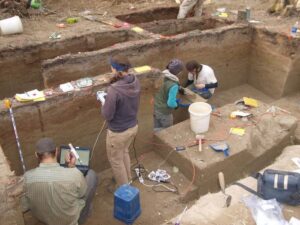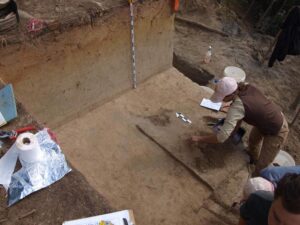Early Native Americans in Alaska may have started freshwater fishing by 13,000 years ago
Native Americans who lived in present-day central Alaska during the last ice age may have started freshwater fishing by around 13,000 years ago, suggests a new analysis* of ancient DNA and stable isotopes from fish remains. Ancestors of Alaska Natives, many of whose livelihoods still depend on freshwater fish such as salmon, may have started subsistence fishing as a response to fewer food resources during long-term climate change, Ben Potter and colleagues say. Native Americans have relied on freshwater fish for thousands of years, but the origins of fishing in North America have been uncertain. Beringia, a region comprising present-day Alaska and Russia, was largely ice-free during the last ice age and is considered a key gateway to the Americas. Researchers have previously discovered well-preserved fish remains in Beringia, but it has been unclear when and how freshwater fishing began there. To investigate, Potter et al. used a combination of DNA and isotope analyses to identify 1,110 fish specimens recovered from six human settlement sites – including in the Tanana, Kuskokwim, Susitna, and Copper River basins – in what was once eastern Beringia (central Alaska). They identified four main fish taxa – salmon, burbot, whitefish, and northern pike – whose earliest appearances dated to around 13,000 and 11,800 years ago. These findings, along with well-documented fishing records from local Native Alaskans, suggest that early Native Americans may have started fishing as a response to environmental change during the Pleistocene-Holocene transition. “Our data collectively suggest that changes in climate and ultimately key mammal resources during the Younger Dryas led to human responses of widening diet breadth to incorporate multiple species of freshwater and anadromous fish, setting a pattern that would be expanded upon later in the Holocene as fish, particularly salmon, became key resources to Alaska Native lifeways,” the authors write.
_____________________________

USR excavation. Ben Potter
_____________________________

Mead Excavation. Ben Potter
_____________________________

Mead articulated burbot vertebrae. Ben Potter
Related Post
A shocking documentary proves that mermaids do exist
SHOCKING Revelation: Thuya, Mother of Queen Tiye, Was the Grandmother of Akhenaten and Tutankhamun—What Ancient Egyptian Secrets Did She Leave Behind?
Breaking News: Astonishing Discoveries at Karahan Tepe Confirm an Extraterrestrial Civilization is Hiding on Earth, and NO ONE Knows!
Breaking News: Researchers FINALLY Discover U.S. Navy Flight 19 After 75 Years Lost in the Bermuda Triangle!
NASA’s Secret Investigation: Uncovering the Astonishing Mystery of the UFO Crash on the Mountain!
Explosive UFO Docs LEAKED: Startling Proof That Aliens Ruled Ancient Egypt!